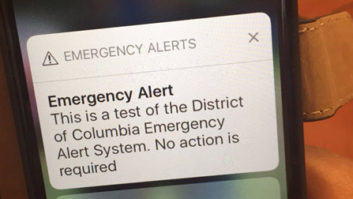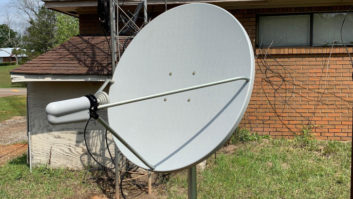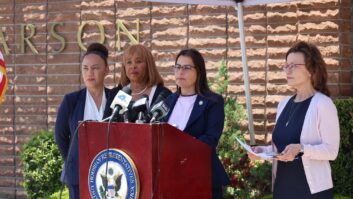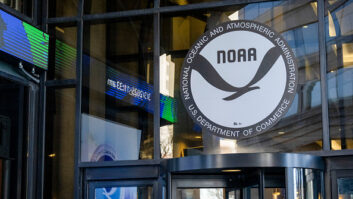Congress is pushing the FCC for better emergency alerting in the United States and a review of public comments on the latest proposed improvements shows most stakeholders are focused on the ability of the system to repeat national alerts from the president or FEMA if necessary.
Changes are coming to EAS after the Reliable Emergency Alert Distribution Improvement (READI) Act passed Congress earlier this year and mandated emergency alerting reforms in this country.
[Read: Changes Coming in National Alerting]
Several EAS equipment manufacturers support the commission’s efforts to simplify how national level emergency messages are repeated if necessary. The FCC has acknowledged requiring each EAS participant’s EAS equipment to repeat an alert automatically could present technical complications. Such an upgrade would require firmware or software updates to EAS decoders, EAS experts say.
Sage Alerting Systems agrees with the FCC’s approach in the proposal to repeating alerts: “Reminding originators that they can repeat or update any alert they issue by simply reissuing it, and not making changes to the existing EAS implementation. This greatly reduces the cost to all stakeholders that changes of this level to EAS would cause, and leaves control of repeating information in the hands of originators.”
The EAS equipment maker wrote in its comments that even if protocols are modified and new implementations are pushed into the field, any “automatic system of repetitions could make the overall system more fragile.” Sage continued: “If an errant repeating alert is issued, and the originator can’t issue a cancel, what is the method for removing such an alert, especially if issued via legacy EAS?”
Digital Alert Systems is another manufacturer that supports the manual message repeat approach suggested by the FCC: “Wherein an alert originator may choose to repeat an alert by interactively creating a new alert message is likely the simplest course of action to meet the objectives of the legislation. No modification to existing rules would be necessary.”
However, the EAS equipment manufacturer believes the FCC’s recommended approach would still “require substantial orientation and training among alert originators, and potentially commercial alert origination system providers, so that they may fully understand the features and limitations of each dissemination system.”

The only comments submitted by the National Association of Broadcasters are specifically aimed at the proposed mandate from Congress to allow repetition of EAS alerts for national security events.
“NAB appreciates the simplicity of [the FCC’s] approach. We recognize that the FCC could have proposed any number of more complex, prescriptive methods for implementing. However, the FCC has wisely struck upon an efficient proposal that fits within the existing regulatory scheme, leverages the current architecture of EAS, and is not expected to require costly upgrades to broadcasters’ existing EAS equipment and system,” the NAB wrote.
Another key facet of the NPRM is holding states more accountable for managing alerting infrastructure and how State Emergency Communications Committees (SECC) are structured. And whether those requirements should be adopted as part of the commission Part 11, EAS Rules. There are no current rules covering SECCs.
The Washington State SECC wrote on that topic: “It is true that the structure of SECCs is not uniform nationwide. It would be most helpful if this issue could be corrected. It also would be helpful if the commission’s rules clarified its scope of authority regarding enforcement of critical aspects of the state EAS Plans.”
In addition to more state oversight on emergency alerting, SECC committees would be required to meet at least once a year and submit an updated EAS plan annually, which would be accepted or rejected by the FCC. State plans, currently posted on the FCC website, would not be available to the public except for names and contact information for SECC chairs.
The FCC also invited comment on whether it should replace the WEA [Wireless Emergency Alert] system’s “Presidential Alert” with a “National Alert,” which is an alert mobile users cannot turn off.
REC Networks, a low-power FM advocate, pointed to the political divide in the United States as a good reason for the alert name change. “REC does support the name change of Presidential Alerts to National Alerts, as such a change would better represent the purpose of the alert as opposed to the originator of the alert,” the group wrote.
REC Networks continue: “Because we are now in a blue vs. red and us vs. them culture, the use of the term presidential can be seen as continuing to divide this nation, where the term national would remove any perceived political party influence out of the objective of such alerts, which is to inform and unite the nation. In this case, perception is important.”
Another proposed change would require jurisdictions to report false EAS or WEA alerts to the FCC Operations Center when they occur in order to help prevent future false alerts. One commenter expressed concern about potential backlash for doing so: “The FCC considers requiring FEMA administrators or state, tribal, local, or territorial entities report a false EAS activation or WEA alert when they become aware of such a message, whether or not they originated the message. However, there is no definition of what constitutes a false EAS activation or WEA alert,” wrote Adrienne Abbott, Nevada SECC chair.
Abbott cited several recent examples of false EAS activations in her state and concluded: “The FCC must also consider the impact of requiring an EAS participant to report a false activation to their regulatory agency and possibly running the risk of being fined for an action over which they have no control.”
Reply Comments in PS docket numbers 15-91 and 15-94 are due May 4.







